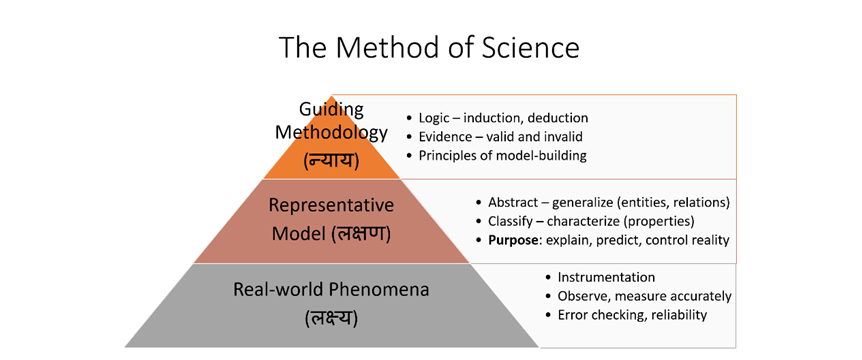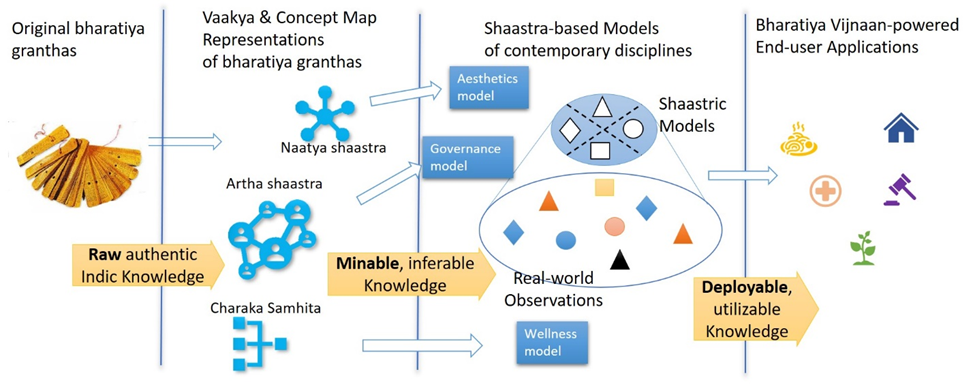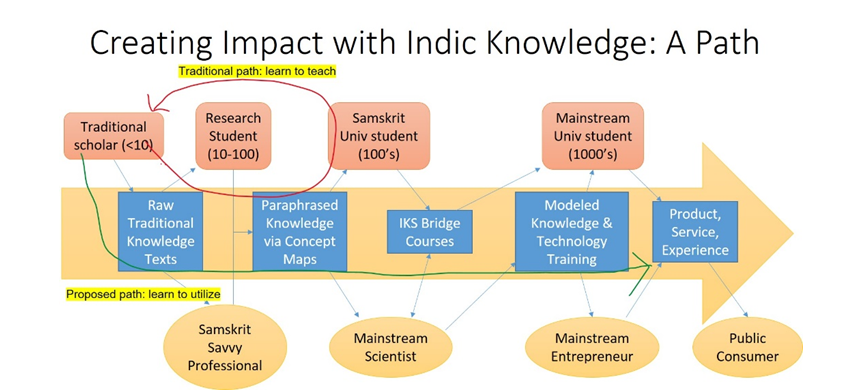Shaastric Modeling: Faculty Development Program by MITSVS
Duration of Program
2 weeks, 5 sessions per week (1.5 hrs each)
Bharat had a long intellectual tradition of systematizing knowledge in diverse disciplines into sophisticated scientific treatises called the Shaastras. This tradition was instrumental in securing its status as the leading prosperous country for millennia. Naturally, a question arises: is there anything in Bharatiya shaastras that is useful in today’s context beyond what modern sciences offer? If so, what does it take to extract and re-contextualize their insights for current conditions?
The aspects covered in this program are:
- Shaastra Mapping:
- How to study Bharatiya texts from a conceptual (तात्त्विक) perspective?
- How to paraphrase a Bharatiya text as a mindmap network of concepts and relations for rapid assimilation?
- How does Nyaaya shaastra knowledge help in grasping Bharatiya texts?
- Shaastra Mining:
- How to use mindmaps of Bharatiya texts to answer complex queries on their subject matter authentically?
- How to systematize knowledge extraction and mining across multiple texts?
- Shaastric Modeling:
- How to study a contemporary western discipline from a shaastric perspective?
- How to derive a scientific model out of shaastras for comparison with contemporary models/theories of a discipline?
- What are the different paradigms for model-building offered by the Indic tradition? How to choose the appropriate modeling paradigm for a discipline?
Objectives
This pioneering workshop by MIT School of Vedic Sciences offers training on how to approach Bharatiya shaastras to extract key universal concepts from their original contextual presentation so as to reinterpret them for modern needs. Its aim is to transform a shaastra-jna (knower) into shaastra-kaara (composer) by imparting the following new skills to spur innovative shaastra-based contributions to the world’s knowledge.
Outcome
After attending this program, the participant will be able to
- Paraphrase (samanvaya) a flat shaastra text into a queryable concept map
- Use a concept map to answer complex questions on shaastra content
- Present the summary of a knowledge area using concept mapping
- Create the ontology of a contemporary knowledge discipline based on Shaastric principles
With these skills, the participant will become eligible to participate in Applied Shaastra projects of MITSVS and Vedavaapi Foundation.
Program at a Glance
- Title: Shaastric Modeling: Re-contextualizing Shaastric Thought
- Organizers: MIT SVS Pune and Vedavaapi Foundation Bangalore
- Instructors: MIT SVS faculty and Prof. Shrinivasa Varakhedi, VC, KKSU, Ramtek
- Why Attend: Hands-on training to paraphrase Shaastra texts into Mindmaps and participate in Concept mapping and new Shaastric modeling projects
- Delivery Mode: Online via Zoom
- Duration: 2 weeks, 5 sessions per week (1.5 hrs each)
- Date: 15th October – 29th October 2021
- Audience:
- Scholars steeped in Shaastric teaching-learning in Gurukulas / PaaThashaalas
- Scholars teaching Shaastra through Samskrit medium for 3 years or more in any educational institution including Gurukulas / paaThashaalas
- Shaastra faculty teaching in Samskrit Universities
- Samskrit faculty teaching at University departments or colleges with fluency in Shaastric Samskrit
- Post doctoral fellows (completed or pursuing) in Shaastras with fluency in Shaastric Samskrit
- Research scholars with firm grounding in Shaastras from Gurukulas/PaaThashaalas/Samskrit Universities
- Fee: Rs. 4,800/- (India residents), USD 90 (non-India residents),
- 50% off for Research scholars (copy of current University Student ID required)
- Certificate: Available subject to attendance in all sessions and evaluation.
- Medium of Instruction: Mix of Samskrit and English
Model-based Reasoning – The Method of Science

Model-based reasoning is the hallmark of contemporary science. The purpose of science is to study a real-world system / phenomenon to explain why it is the way it is, predict how it will be under in hypothetical conditions and control it to benefit someone. The subject matter of a scientific discipline is the system it studies. Examples include the human system, society, nation, politics, matter, energy, life etc. The method of science is to gather unbounded observations about a system using human senses or their extension tools and augment them with logical inference to arrive at a compact representation of the system, called its model or theory. A model describes the system in terms of a finite set of synthesized properties or categories called its taxonomy. A model makes the system amenable to logical reasoning by reducing its complexity to a manageable level. The closer a model is to the principles (or tattva) governing the system, the more accurately it can explain, predict and control the system. The validity of a model can be established based on how many real-world observations it can represent with what accuracy.
Models can be synthesized in three ways – top-down, bottom-up and hybrid. A bottom-up model starts with the observations and looks for recurring patterns from which to categorize them into finite classes. This is the data-driven method. A top-down model postulates a theory or logical structure that captures the fundamental nature of the system, and tries to test it with live observations. A hybrid model, in addition, has the facility to refine the representation based on real-world observed data.
Approaching Bharatiya Shaastras as Models
The function of a Bharatiya shaastra is similar to modern science, namely, to characterize a real-world system / phenomenon (विषयः / लक्ष्यम्) by devising a finite set of sound properties (लक्षणानि) for serving a purpose (फलम्) – namely, to explain, predict and control the system / phenomenon – that benefits someone (अधिकारी) in a way that no other shaastra does.
However, Bharatiya Shaastras as available today were composed in a context different in many ways from the current social, political, environmental and lifestyle context. Though they have elements that offer first-principles or taattvic insights valid universally, their texts needs to be revisited to extract those core insights from context-specific parts, so as to re-assess their applicability today. The formula is
Practice (or shaastra as expressed) = Principles (tattva) applied to a Context (sandarbha)
For modern education to be enriched with Bharatiya knowledge systems, the latter must be expressed in a way intelligible to modern academic community. We intend this workshop to be a step in that direction.
Workshop Objective
The objective of the Shaastric Modeling workshop is to train people to help re-contextualize shaastras for the modern academic and societal context, and to create new shaastric models for contemporary disciplines by drawing from traditional insights. To do so, we need an interdisciplinary team of traditional scholars and modern domain experts educated in the core insights of relevant shaastras to work together.


Approach
We have identified the following training to be imparted to re-contextuallize Bharatiya Knowledge for novel application:
- Shift from Text-based to Concept-based Learning: The educational skillset and resources of contemporary mainstream students is different from that expected for traditional study of shaastras. Modern education has de-emphasized memory skills and focused more on analytical skills and conceptual study. To train them in shaastric insights rapidly for shaastric modeling, shaastras need to be paraphrased for conceptual study and drill down to details as required. Mindmaps help in this regard.
- Embrace model-based reasoning with a shaastric basis: For traditional scholars to present shaastric insights in a form that is intelligible and useful to the mainstream academic community, they need to be trained in model-based reasoning which is the hallmark of western science and to present shaastra as a universal model beyond its textual context. To do so, they should learn to probe the author’s thought process behind a shaastra statement. This helps glean universal insights from shaastra exposition.
- Express modern scientific concepts in Shaastric terms: To be able to develop shaastric models for contemporary disciplines, one must learn to study a modern discipline with an eye for its practical utility, to identify shaastric equivalents of modern concepts and to express the latter in shaastric terms.
MIT SVS has developed a Nyaaya-based structured mindmapping mechanism to represent a shaastra’s discourse, called the Shaastra Map, or S-Map in short. This workshop introduces the S-Map, how to build it from raw shaastra text and how to use it to answer questions. By representing Shaastra in the form of an S-Map we intend to abstract out the Principles that have been used by Shaastrakaara to create a Shaastra from its original context. Once these universal underlying principles are available, we can then interpret them for the modern context to develop new Shaastra-based insights and applications / practices / solutions for contemporary issues.
Syllabus
Total of 10 sessions @ 1hr 30 mins per session.
- Answering a question from a textbook vs. from a concept map
- Definition of a term
- Argument about a hypothesis / pratipaadanam
- Summarization of a discussion
- Reasoning questions – why
- Discourse Structure of a shaastriya grantha – beyond Table of contents (vishaya-suuchii)
- How is a concept map different from table of contents
- Vaakyas vs. concepts (vishayas) – how to identify them
- Extracting concepts from Vaakyas – वाक्यात् विषयस्य उद्धरणम्
- Study of Vaakyas
- Vichaarah = discourse, vaakyam = artha-bodhakaH thought
- Discourse is a set of sentences that enable us to identify interconnection among thoughts
- Ekavaakyataa (mahaa-vaakyam)
- Possible linkages between sentences – tantrayukti
- Types of vaakyas
- Types of relations between vaakyas
- Prayojanam of Vaakya Map
- Definitions
- Summary
- Argument
- Exercise: Demonstration through 2 examples
- Study of Vishayas / concepts
- Types of vishayas
- Dravya, guna, karma, saamaanya, abhaava (what is absent?, where is it absent?, in what way is it absent)
- System, property, attribute, state, action
- Types of relations between vishayas – Nyaaya-sambandhas
- Exercise: Demonstration with 5 examples
- Home work: Identification of types
- Types of vishayas
- Introduction to Shaastra Map-making
- Building a Vaakya map
- Building a Vishaya map
- Using a Vaakya map
- Using a vishaya map
- Home work: Build a vaakya and vishaya maps for 10 sentences
Types of Questions on a shaastra:
- Based on the 4 limbs: Vishaya, prayojanam, adhikaari and their relations
- What questions
- What is ….?
- What are the lakshanas of ….?
- Why questions
- Why given action transforms a dravya from state 1 to state 2
- How questions
- How to transform a dravya from one state to another
- Using a shaastra map to answer above questions
- Templates of how to answer each type of question
- Exercise: Demonstration
- Home work: Answer 10 questions from given map including steps taken.
– Repeat 3 and 4 one more time.
- How to paraphrase a real-world problem / question into a shaastra question
- Jyotisha example, Ayurveda example, Yoga example
- Different perspectives of looking at a system / organism
- Nyaaya-vaisheshika, Saankhya, Miimaamsa and Vyaakarana perspectives
- Their relative utility
- When to use what
- Method of inquiry into a contemporary science
- Extracting shaastric structure from a contemporary science via question series
- Prayojanam – Jijnaasaa
- Shaastric modeling of contemporary discipline
- Identification of entities, properties, states, actions and relations
- Psychology



